5 Ways Banks Can Adapt Their Social Media Strategy During COVID
There’s been no shortage of challenger banks popping up since 2009. Over the past decade, online and digital banking have become the norm.
Yet, some banks and credit unions still lag behind.
The coronavirus pandemic has shined a spotlight on them all. Now, these idle institutions must pick up the pace or risk closing their doors for good.
But with fewer people visiting branch locations, how do banks attract new customers? How do they flex their competitive advantage to connect with their current audience while winning over new ones?
The answer lies in your social media banking strategy.
Here are five COVID social media strategies for banks (along with examples of institutions that have done a phenomenal job so far).
Let’s dig in.
1. Banks can use segmentation data to meet customer needs.
As a bank, you already have oodles of customer segmentation data at your fingertips. Use this data to identify which customers need specialized support and which ones are better positioned to make it through the crisis.
Speak to your customers’ financial pains. Show them you care by offering actionable advice and guidance on how they can survive this financial crisis.
American Express decided to help its card members manage stress by giving them a free one-year subscription to Calm.
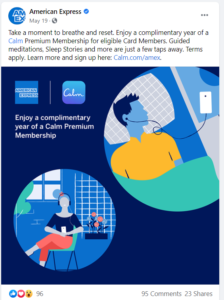
US Bank helped its customers navigate income loss and a tough job market with helpful guidelines and webinars. Here are three Facebook posts they released over the span of a month:
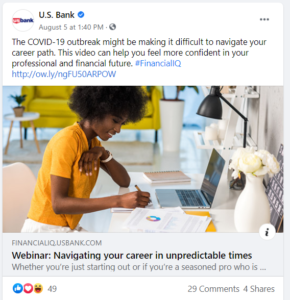
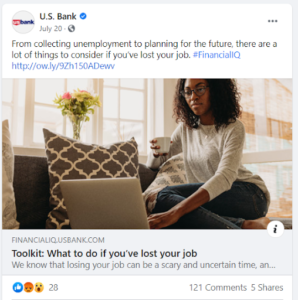
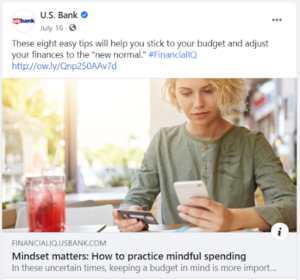
2. Don’t be afraid to go “off-platform” with your marketing message.
Customers are scared. They’ve lost their jobs. They’ve lost loved ones. Their whole world has been turned upside down and they’re looking for help on what to do. Financial institutions are in a unique situation to pivot their marketing strategies to focus on education and communication.
Many banks have started creating unique and successful webinars to educate their clients. For example, Azlo — a neobank providing services to small businesses — has created webinars on:
- Understanding PPP loan forgiveness
- What now? Small business lending Q&A
- How to grow your business through SEO & content marketing
- The art of website optimization
Some of these topics are off-platform for a bank (i.e. How to grow your business through SEO & content marketing and The art of website optimization), but Azlo understands that many of its customers are struggling as they’ve had to shut down their businesses. Now they’re helping them transition online.

Even though these marketing webinars aren’t related to banking, Azlo is showing their customers they care more about their financial well being than pushing services.
3. Reassess your content calendar.
Now is the time to re-evaluate your marketing campaigns to make sure they’re still appropriate in the COVID era. The last thing you want to do is release a post promoting a travel credit card someone can use on their next trip to Italy when there’s a ban on international travel — whoops!
When assessing your social media content calendar, consider:
- Delaying product launches. You don’t have to scrap untimely product launches altogether, but you should at least delay them until the pandemic starts to settle.
- Redirecting focus to overlooked services. When the economy is booming, customers may not care as much about some of the loans and financial education services you offer. Use this time to touch on the benefits of those services.
- Picking the right imagery. There are several design takeaways in the COVID era. One of the main ones is to avoid using images of large social gatherings — especially while everyone is still social distancing.
- Highlighting what you’re doing in the community. People care about social responsibility. Your customers want to know what measures you’re taking to keep them, your employees, and the community safe.
Here are two examples of banks that have excelled at picking the right imagery and highlighting ways they’re giving back to their community.
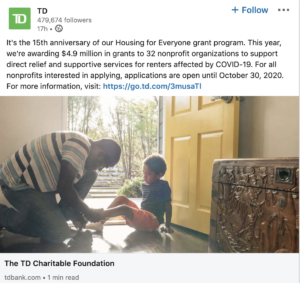
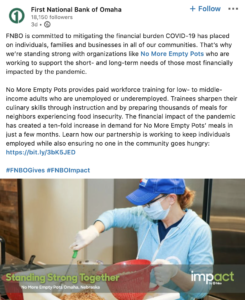
These types of posts go a long way in building brand loyalty.
4. Create a dedicated hub for all your coronavirus content.
As you continue to build out COVID-related social media strategies for your bank, think about where your followers can go for more information.
We recommend setting up a central page on your website for all your COVID material. As you build out your site, you can push this information out to the appropriate social media channels. For example, you can use:
- Twitter for updates on relief packages, policy changes, and breaking news
- LinkedIn for business updates
- YouTube for video updates
- Instagram for sharing stories and consumer updates
- Facebook for consumer updates
At Vested, we created an entire microsite for coronavirus content, so CMOs and other executives have a dedicated space to learn more about how the pandemic is shaping the financial services industry.
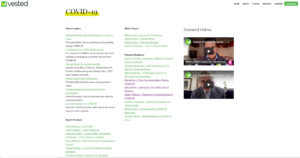
Here’s a social media post we created to promote our microsite:
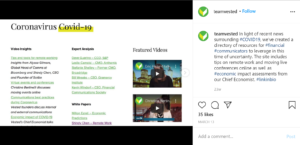
Azlo also created a COVID resources page on its website at the start of the crisis. Here’s an example of their hub:
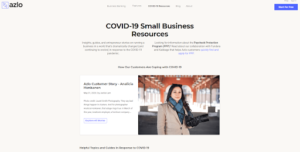
Here’s an Instagram post they used to promote it:

5. Use social media to share first-person experiences.
Everybody loves a good story — especially ones of trials and triumphs. Share first-person stories of your customers and how they’ve overcome certain challenges during COVID.
Here are a few examples that demonstrate the impact of personal stories successfully told through banking brands:


Although neither of these examples explicitly call out customers’ journeys, they act as teasers that feel both genuine and compelling without being sales-y.
What does the future hold for the banking industry?
The banking industry was experiencing massive growth before the pandemic hit. But within a matter of weeks, everything changed.
The financial institutions that survive the pandemic will be the ones that embrace online and digital banking, provide excellent customer service, and leverage their online presence to connect with their audience on a deeper level.
It’s too soon to know what the banking industry will look like after the dust settles. But we do know that COVID will change the way people bank forever. We suspect more brick and mortar banks will continue to make the shift online — especially with social distancing remaining in effect for the foreseeable future.
Now is the time for your bank to embrace technology. Currently, there’s a level playing field. Every institution is in the same boat. Use this opportunity to shift your banking social media strategy and use it as a tool to retain customers, beat the competition, and stand out from the crowd.
Want to check out more content on marketing during the coronavirus pandemic? Check out our COVID-19 microsite.


